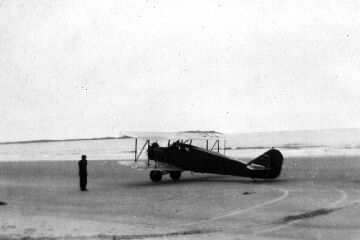The Old Orchard Beach airfield was a strip of beach, in Saco Bay,
along the coast of Old Orchard Beach, Maine that had a useable runway at
low tide and was officially established on August 11, 1921, by the town
of Old Orchard Beach, which was named for the apple orchards that once
stood on the hill overlooking the beach. It had a hangar owned by Harry
Jones, who was an aviator that had been flying since 1912, and it was used
as the starting point for the attempted transatlantic flight of the Fokker
VII Old Glory, flown by James
DeWitt Hill and Lloyd W. Bertaudon, on September 6, 1927,
and the three aborted transatlantic flights of the Sikorsky S-38 Dawn,
piloted by Wilmer Stulz, in October 1927,(1) including one on October 23rd.(2)
Both aircraft, however, were lost over the Atlantic Ocean.
A successful transatlantic flight was made from the Old Orchard Beach
airfield, when French aviators Jean Assolant, Rene Lefevre, and Armeno
Lotti flew their Bernard 191 G.R. Oiseau Canari (Yellow Bird)
monoplane, with 22-year-old Arthur Schreiber, as a stowaway, 3,418 miles,
non-stop, to a beach at Comillas, about 25 miles from Santander, Spain,
in about 30 hours, from June 13-14, 1929. This was the first French non-stop
transatlantic flight and despite the added weight of the stowaway, which
forced them to dump fuel and change their original destination, from the
Le Bourget airport, at Paris, France, and almost caused them to crash into
a seawall, on takeoff,(3) they still set transatlantic flight records for
speed and distance.
An unsuccessful transatlantic flight was also attempted, from the
Old Orchard Beach airfield, on June 13th, by the Bellanca J Green Flash
monoplane, with registration number NX5315, which was flown by Roger Quincy
Williams, as pilot, and Lewis Alonzo Yancey, as navigator. It attempted
to take off, for Rome, Italy, just behind the Bernard 191 G.R. Oiseau
Canari, but one of its wheels collapsed, forcing it to abandon its
flight. Its aviators, however, were successful on another transatlantic
flight, from the airfield, to Santander, Spain, and then Rome, on July
9th, 1929, using the Bellanca J Pathfinder monoplane, with registration
number NX3789.
The Old Orchard Beach airfield was also visited by transatlantic
flyer Charles Lindbergh and his
Ryan
Ryan
B-1 Brougham NYP Spirit of St. Louis on July 24, 1927,
during his 1927 tour of American cities, after he could not land in Portland,
Maine, because of fog. The Friendship Motor Inn, built in 1970, on East
Grand Avenue, near Ladd Avenue, now occupies the site of Harry Jones' hangar,
at the airfield.
(1) Page 49, Joshua Stoff, Transatlantic Flight, Dover Publications,
Mineloa, 2000.
(2) Page 247, Bill Gunston, Aviation Year
by Year, Dorling Kindersley Limited, London, 2001.
(3) Page 72, Joshua Stoff.
FRIENDSHIP
MOTOR INN
HARRY JONES
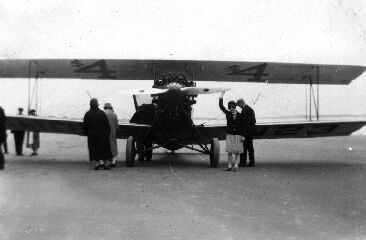
Harry M. Jones' Stinson Detroiter SB-1, with registration number
3123, at the Old Orchard Beach airfield, in September 1927. Jones had a
hangar at the airfield, for his Jones Flying Corporation, and gave sightseeing
flights. He had made the first air mail flight in Maine, on October 23,
1919, flying from Portland to Augusta, and the first parcel post flight,
from Franklin Park, in Boston, Massachusetts to New York, which started
on January 13th, 1913 and took about 52 days to complete. He landed in
Brooklyn, New York on March 30th and completed his flight the next day,
on March 31st. He was born in 1890, learned to fly in 1912, and died on
April 15, 1973, at the age of 82 years old. The woman who is holding the
propeller, in this photo, later took a ride in the airplane and may have
taken many of the photos that appear on this web page.
|
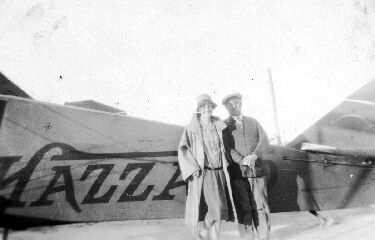
Alfred Morse's aunt and uncle, Mr. and Mrs. Morse, standing in front
of Harry Jones' Stinson Detroiter SB-1, with the advertising for Hazzard
shoes on its fuselage.
|
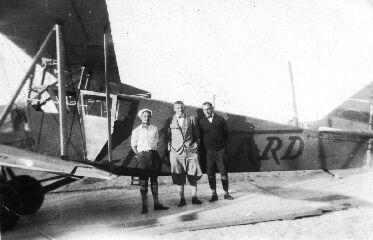
Harry Jones, standing between his mechanics, Alfred Morse and Louis
Burnell, and his Stinson Detroiter SB-1, which has advertising for Hazzard
shoes, on its fuselage, in September 1927. The upper wing has "$4" painted
on it and the lower wing has "Shoes" painted on it. The Hazzard shoe company
was owned by Robert P. Hazzard. The Jones Flying Corporation later had
a Bellanca CH monoplane, with registration number NC274E, around 1933,
and had used a Standard J-1 biplane, earlier.
|
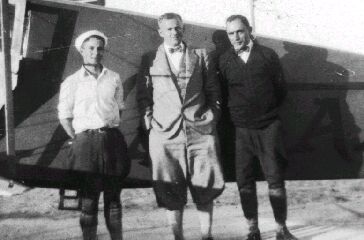
A closeup of the photo on the left.
|
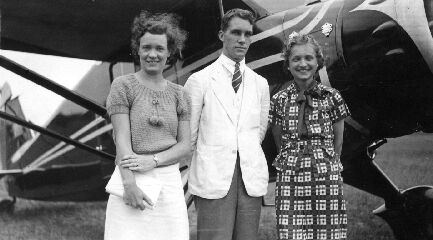
Many of the photos on this web page may have been taken by the woman
on the left, in this photo. She is standing next to Arthur Tappan, the
pilot of the Stinson R shown in this photo, and Josephine Gorene, at the
Hyannis Airport, on August 11, 1935. The descriptions of these photos are
based on what is written on the back of them.
|
|
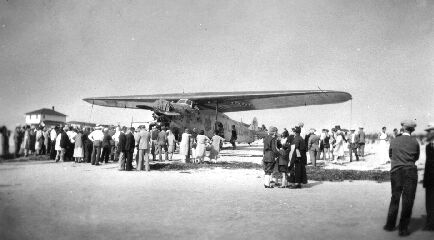
Former
United States air mail pilots James DeWitt Hill and Lloyd W. Bertaud, along
with Philip Payne, the editor of the newspaper Daily Mirror, attempted
a transatlantic flight, from Old Orchard Beach, Maine, in the Fokker F-VIIA
Old
Glory, on September 6, 1927, at 12:23 p.m., but were lost over the
Atlantic Ocean. James Hill, who had obtained his pilot's license in 1913
and had over 5,000 hours of flight time, was the copilot for the flight
and was at the controls of the Old Glory, when it took off from
Old Orchard Beach. These photos shows their silver and gold painted aircraft,
which had been purchased for their flight by magazine publisher William
Randolph Hearst, at Old Orchard Beach, in August of 1927.
|
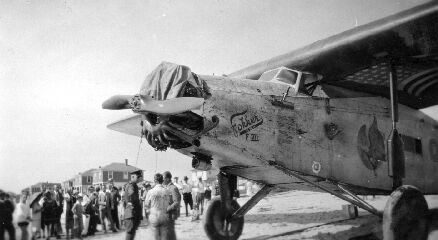
The Old
Glory at Old Orchard Beach, in August of 1927. Wreckage from the aircraft
was later found, on September 27th, in the Atlantic Ocean, by the ship
SS
Kyle, which had been chartered by William Hearst, for a rescue search,
and it has been speculated that the Old Glory was overloaded with
fuel, when it crashed, as Lloyd Bertaud had radioed, at one point in the
flight, that the aircraft was flying heavy. The last messages from the
Old
Glory, at 3:57 p.m. and 4:03 p.m., on September 7th, were distress
messages that were made by Lloyd Bertaud, who had originally been selected
to be the copilot for Clarence Chamberlain, on his June 1927 transatlantic
flight, in the Wright-Bellanca WB-2 Miss Columbia, until the president
of Bellanca, Charles A. Levine, decided that he would accompany Chamberlain
on this flight.
|
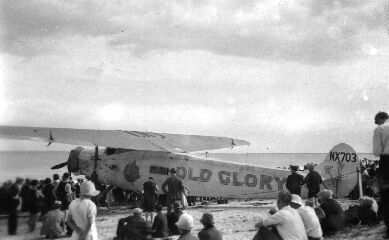
The Old
Glory at Old Orchard Beach, in August of 1927. Three other attempted
transatlantic flights would also be made, from the Old Orchard Beach airfield,
in October 1927, by the Sikorsky S-38 Dawn, which
was sponsored by Mrs. Aage Ancker and crewed by pilot Wilmer Stulz, navigator
Brice Herbert Goldsborough, and Mrs. Francis Wilson Grayson, who would
have been the first woman to make a transatlantic flight, had the Dawn
reached its destination, but they were aborted on takeoff. After Wilmer
Stulz quit the flight, due to the approaching winter weather,(1) Norwegian
Lieutenant Oskar Omdal was hired as the pilot and Frank Koehler was hired
as the radio operator, and the flight took off from Curtiss Field, in New
York, for Harbour Grace, New Foundland, on December 23, 1927, but this
airplane also became lost at sea, in stormy weather.
(1) Page 49, Joshua Stoff, Transatlantic Flight, Dover Publications,
Mineloa, 2000. David Beaty, however, claims that Wilmer Stulz declined
to make another attempt with Francis Grayson, because he had another offer.
Page 64, David Beatty, The Story of Transatlantic Flight, Airlife
Classic, Mechanicsburg, 1976. Wilmer Stulz would later make a transatlantic
flight, in the orange and gold Fokker F.VIIb-3M Friendship trimotor
seaplane, on June 17, 1928, from Trepassey Harbor, Newfoundland to Burry
Port, Wales, in the United Kingdom, with Louis Edward Gordon, as copilot,
and Amelia Earhart, as a crewmember. This flight, of about 21 hours, was
sponsored by Amy Guest and it made Earhart the first woman to fly the Atlantic
Ocean. She would later make the first female non-stop solo transatlantic
flight, in a red Lockheed 5B Vega, during May 20-21, 1932, from Harbour
Grace to Culmore, near Lodonderry, Ireland, in 14 hours and 54 minutes.
|
|
